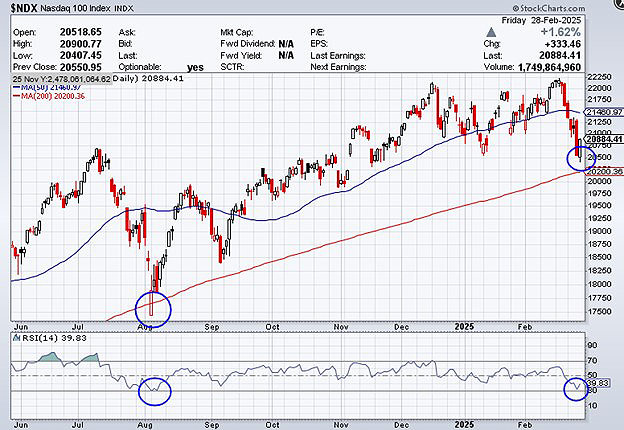WEEKLY MARKET SUMMARY
Global Equities: Risk-off was the theme as investors shunned big technology stocks despite another quarter of record earnings from Nvidia (NVDA) and inflation data that came in as expected. Investors were mostly focused on the potential impact of tariffs on Canada, Mexico, China, and now the European Union as well. The S&P 500 closed out the week -1% lower, the Dow Jones Industrial Average closed -1.1%, and the Nasdaq Composite lagged with a -3.5% weekly pullback. Small Cap stocks were also in the red with a -1.5% decline. Foreign developed market stocks outperformed with a 0.1% positive performance, while Emerging Markets shed -3.8% during the weekly session.
Fixed Income: 10-Year Treasury yields moved sharply lower, closing out the week 20 basis points lower at 4.22%. The decline in interest rates was good news for prospective home buyers, as it pushed the average 30-year mortgage rate to a 2025 low of 6.76%. Despite the risk-off sentiment in stocks, high yield bonds had a surprisingly good week, gaining 0.6% and shrugging off any concerns about a possible recession.
Commodities: US West Texas Intermediate (WTI) Crude prices continued to slide lower, ending the week at $69.95 per barrel. Prices had fallen even lower before President Trump canceled a Chevron license to operate in Venezuela. Gold prices slipped from the cusp of the elusive $3,000/oz mark and ended the week at $2,867.
WEEKLY ECONOMIC SUMMARY
PCE Inflation: The Fed officially measures inflation using the Core Personal Consumption Expenditures (PCE) Index, which came in as expected at 0.3% in January, equating to a 2.6% annual rate. Much of the persistent inflation has come from the services sector, but the January PCE showed a shift towards goods price inflation, which came in at 0.5% compared to a 0.2% rise in services. There was little market movement in response to the data release, as it did not move the timeline for the Fed to resume rate cuts, expected in the second half of 2025.
GDP Worries? The second reading of fourth quarter 2024 Gross Domestic Product was unchanged at 2.3%, which kept the prior Real GDP increase of 2.8% for the calendar year 2024 unchanged. Strong GDP growth has given the Fed confidence to wait-and-see on rate cuts, but there could be an acceleration to that timeline if the Atlanta Fed’s GDPNow model proves accurate. The forecasting tool’s Q1 2025 projection was revised sharply lower from 2.3% to negative 1.5%, an uncharacteristically large change. An update to export projections from -0.4% to -3.7% was the driving force behind the change, suggesting the Trump administration’s aggressive trade negotiations could result in short-term economic pain.
Earnings Update: There was massive anticipation surrounding the mid-week release of Nvidia’s fourth quarter 2024 results, with an option-implied move of plus-or-minus 9% ahead of earnings. Nvidia once again easily beat expectations with an 80% annual increase in earnings per share and $11 billion in quarterly revenue from Blackwell GPUs alone. The initial market reaction was surprisingly muted but then shares turned sharply lower on profit-taking and general market risk-off sentiment. The week ended with Nvidia down -7.1%. Overall, earnings have been solid this quarter, with 97% of the S&P 500 having reported and 75% of those companies beating earnings expectations.
CHART OF THE WEEK
The Chart of the Week looks at the Nasdaq 100 index over the last nine months. The index has fallen within striking distance of its 200-day moving average for the first time since August 2024. The Nasdaq 100 is also close to hitting an oversold measure (30 or lower) on its RSI (Relative Strength Index). Last time, these events coincided, and the Nasdaq 100 was able to bounce sharply off technical support. We could see a similar move, particularly after Friday’s intraday turnaround. Yet with big tech earnings finished for the quarter and no upside move despite stellar results, risk-off appears to be the mood of investors, at least for the time being.


